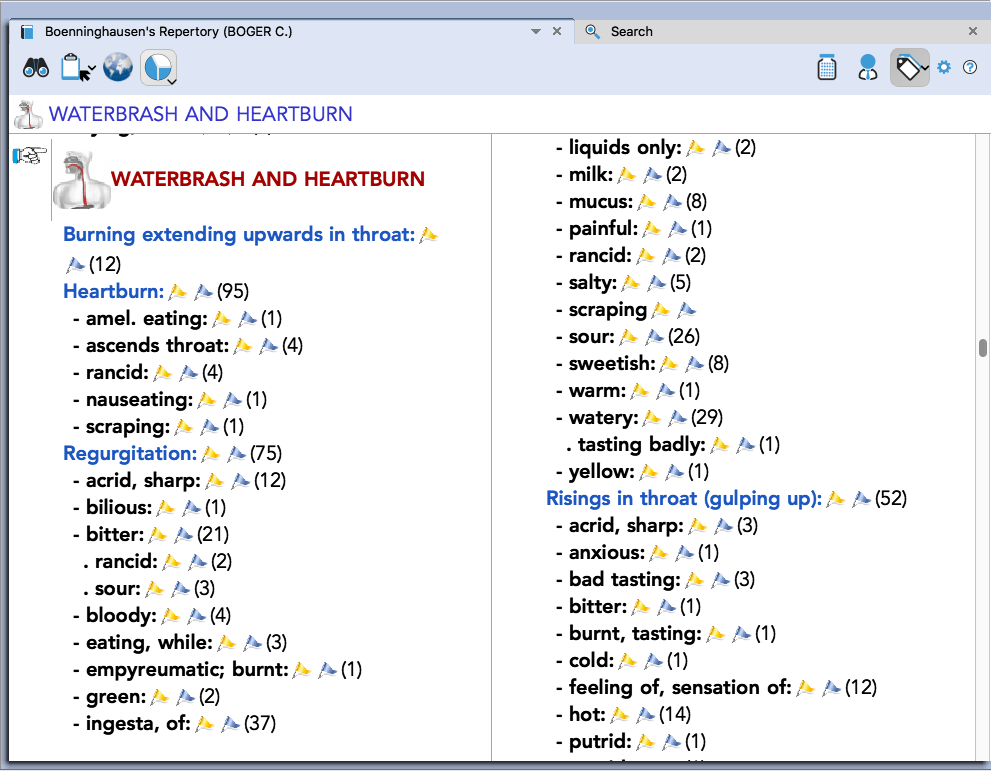Dr Boger was a laborious student of Boenninghausen and as well a German scholar. Hence he was skilled to study, the original efforts of Boenninghausen in German and he correct various faulty or defective translations of his work in English language. What influenced Dr Boger during the indicated studies was the construction of the Therapeutic Pocket Book and its practical usefulness. He, consequently, adopted the plan of the Therapeutic Pocket Book and enlarged that effort considerably into what we can call the “Boenninghausen’s Repertory and Characteristics”. The Repertory, circumscribes in one volume the several efforts of Boenninghausen-the original “Therapeutic Pocket Book”, the “Repertory of Antipsorics”, the “Sides of the Body”, the Repertory part of the “Whooping Cough” and “Intermittent Fever” moreover a huge number of paragraphs or sections from the “Aphorisms of Hippocrates”. He as well added to the latest work a number of remedies that were proved after Boenninghausen buried. Then H.A. Roberts narrates this new Repertory as possibly one of the substantial pieces of Homeopathic literature left by Dr Boger, thus there was never a more rigorous student of Boenninghausen. That Dr Boger assembled 105 printed pages of “Additions to Kent’s Repertory” speaks volumes for his profound knowledge of and understanding into the characteristics of the drugs and the construction of Repertories.
Possibly one of the appreciable pieces of homeopathic literature left by Dr Boger is the Boenninghausen’s Characteristics and Repertory. “The combined observations and logic of Boenninghausen and the wide and wise observations garnered by Dr Boger from long years of study and practice,” is the commendation that Dr H.A. Roberts given to Boger. Boger surely helped the profession or affirmation by pulling all his experiences in the evolution of ‘Portrait of Disease’.

Experiencing certain difficulties and struggles in the day to day usage of Therapeutic Pocket Book, Then Boger tried to improve the content and structure of the book by appending many remedies and rubrics drawn from his own clinical experiences and other sources. Therefore, the book has gone through an enormous change, but its fundamentals have remained unchanged. During compiling the repertory, Dr Boger has followed the primary plan and construction of Boenninghausen’s Repertory of Antipsoric Medicines, which can overcome various difficulties overlooked in using the Therapeutic Pocket Book. Unlike Boenninghausen, he has made various sections for the different parts of the body and he also added various rubrics and sub-rubrics. Although The chapter on Fever has completely changed in its arrangements along with its contents for easy and simple reference. Although, he used the identical or same gradation as that of Boenninghausen. This repertory embraces the antipsoric and the psoric repertories, the repertory part of the intermittent fever, the sides of body and of whooping cough as well as a huge number of paragraphs from aphorisms of Hippocrates. In order to understand the book, it’s imperative to acquaint intellect with its plan, construction and arrangement.

Most of the portions and sections in the book begin with the rubric ‘In general.’ The rubric groups those prominent remedies, which are efficient in constructing different types of symptoms in relation to the location/organ. Therapeutically, these medicines have an affinity concerning those particular organs. This grouping might not help us in the process or procedure of systematic repertorization, but it could be of much help to know the affinity towards the parts. Although It suggests organ remedies, that can be helpful for finding out a medicine for palliation, when rarely a few prescribing symptoms are approachable in the case. Thus Location rubrics are followed by further subdivisions of parts/organs, with each and every part possessing rubrics like ‘side’ and ‘extending to’. besides the location, different sensations are arranged in an alphabetical order. Thus Each sensation is a general rubric, that is followed by a group of remedies. Then It is divided into sub-rubrics under which, parts are included or mentioned. Rubrics for the sensation of pain are further divided into many types of pain which are, burning, aching etc. Basically these sub-rubrics are too particular and have a fewer number of remedies. Although, these sub-rubrics are little useful in repertorization. The rubrics for sensation and location are mixed and there are no distinct headings given for them, but it is simple to acknowledge because there is an order, that is, after sensations, locations are arranged in an alphabetical order. This is followed by time, aggravation, amelioration, concomitant and cross-reference.

